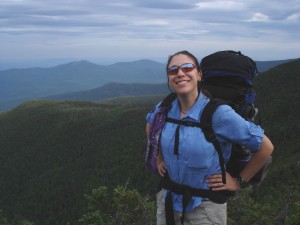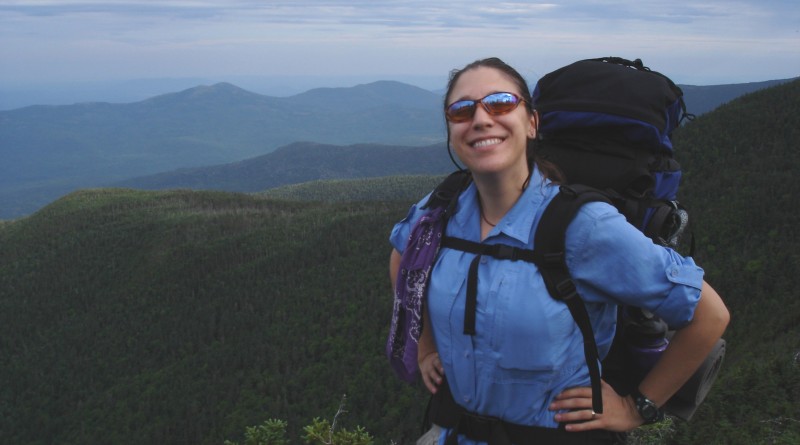Kristin Rokos | Reader Athlete Dec. 2011
Age: 34
Residence: Northfield
Family: Husband, Chris; four cats, Luna, Willow, Gypsy, and Merlin; parrot named Trail Mix
Occupation: Corporate jet captain
Primary sport: Hiking, trail running
VS: In August you planned to run all of Vermont’s 4,000-foot peaks to raise money for the Lucy Mackenzie Humane Society in West Windsor, in an event you called Foot to Paw. Did you make it?
KR: I did. I started up Killington just before 3 a.m. and came down the Mount Mansfield Toll Road at 10:45 p.m. The hardest part wasn’t the physical activity, but the efforts to fundraise, build a website and get media attention during the previous two weeks, which was almost a full-time job. Running almost felt like the relaxing part.
VS: Tell us about the logistics.
KR: We had everything packed the night before, including food, water, first-aid materials, extra batteries and fliers to hand out in the parking lots explaining Foot to Paw. I ran up Killington by myself, but my father joined me for Mount Abraham and Mount Ellen which we combined. My husband ran up Camel’s Hump with me and then my father joined me for Mount Mansfield.
VS: Was it better with company?
KR: It was a real treat to run with my father who is an ultra runner. He’s strong, but he’s a bit slower. My husband actually got a bit worried because I thought we’d do Mount Abe and Mount Ellen in three-and-a-half hours, but it took close to five. On Camel’s Hump, my husband did an awesome job staying with me and keeping pace. It was wonderful to spend that time with him.
VS: What was the hardest part?
KR: The hardest part was starting up Killington at 2:58 a.m. No matter how many times I head off solo in the dark, it takes me at least 45 minutes to relax. You do a lot of talking to yourself, but at a certain point you realize you can just sit there and freak out, or you can keep going. I suppose that’s a good metaphor for life. The trail is probably also used by snowmobilers, because there were these little reflectors high on the trees that caught my eye; I’d think it was an animal. I finally realized that anything I came across in the woods at 3 a.m. would be more afraid of me than I am of it. The other weird thing was my headlamp was so strong that moths were congregating a foot from my face so I had to turn it down.
VS: Did you meet other people on the trail?
KR: Not surprisingly, there was nobody at Killington, although I think I woke some through hikers who were sleeping near the trail. There were only a handful of people on Mount Abe and Mount Ellen, but we passed two women who answered our questions in tandem, saying the exact same thing, totally in sync. I thought it was hilarious, but maybe that’s because I’d been running since 3 a.m. Camel’s Hump was actually pretty crowded, which was a challenge. What was interesting was that 70 percent of the people had dogs, so they were very receptive to what I was doing. My dad and two friends gave out lots of fliers in the parking lot. By the time I got to Mansfield, it was late and there was nobody at the top, which was cool.
VS: Did you get to admire the view at all?
KR: I took a little bit of time at each summit. On top of Killington, I stopped to look out at the lights of Rutland. With the wind swirling, it was absolutely beautiful. On top of Mansfield I saw an amazing sunset.
VS: Why did you choose to raise money for the Lucy Mackenzie Humane Society?
KR: When I lived in Woodstock, I volunteered there. It’s a no-kill shelter, which is great, because I couldn’t imagine bonding with an animal that might get killed. Three of my cats came from there. When we moved to Northfield, I wanted to do something special for them, since I could no longer volunteer. I raised slightly over $2,000, which is less than I hoped for, but hopefully I’ve increased awareness of the shelter and their no-kill policy.
VS: How did you train for the run?
KR: I did a lot of running on rough trails. I started out on dirt roads near our house, and when the snow melted, I started doing the App Gap from Mad River and back, and then Lincoln Gap. When the trails got clear, I started running at Sugarbush. I don’t run more than four times a week, which usually includes a trail run, a big hill climb, and a run of 10 miles or more with hills. A month before the run, I did Killington, Camel’s Hump and Mansfield in one day. Then I started tapering down. I’ve never had any running injuries, and I’d like to keep it that way, which is why I don’t run every day.
VS: Do you do other sports?
KR: I like ice climbing, rock climbing, solo mountain climbing in the winter, spelunking, hiking, backpacking, and flat-water kayaking, although I’d like to try white water. Eleanor Roosevelt said, ‘you should do one thing every day that scares you.’ A lot of people are just coping with life and not really living, and that’s why I keep pushing myself.
VS: What is the joy of trail running?
KR: When you run, you’re more in tune with your body because you’re pushing yourself. I feel really alive and in the moment. That’s one of the things I like about flying; it forces you to be present. You can’t think about anything else. With flying, mountain climbing and trail running, you need to be 100 percent focused, and that’s really relaxing. Trail running is my drug of choice. It helps me with every other aspect of my life, and makes me strong mentally and physically.


